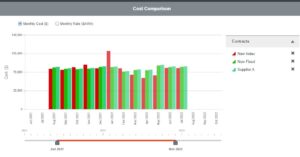Energy markets have gotten more interesting over the past 24 months. We’ve said it before, we will say it again. After approximately 7 years of relatively low prices and low volatility, markets have grown increasingly volatile over the last several years. What can we expect for the coming year? How can customers prepare for dynamic energy markets?
There is a range of conflicting pressures on energy markets, particularly in the Northeast. For example, we can expect:
- Strong natural gas supply and significant availability of natural gas in storage, at least through to the start of next Winter;
- Increasing electrification and high electricity demand;
- Continued efforts to phase-out fossil fuels in power generation;
- Weather;
- Utility and independent system operator investment in improving reliability; and
- Development of new, emerging technologies and designs (hydrogen, battery storage, virtual power plants).
What impact might these various dynamics have on energy markets? High levels of storage, a drop in natural gas prices and a moderation of interest rates puts downward pressure on power and gas prices. However, weather, reliability concerns, increases in electricity demand, and an effort to phase out fossil fuels will likely put upward pressure on energy markets, particularly in the short and medium term (1-3 years). There are cross-cutting influences on energy markets.
As reported by Utility Dive, “For utilities and the clean energy sector, 2024 could bring “an exceptional level of volatility and opportunity,” according to Bank of America Global Research analysts.”
Make an energy plan now
Don’t get caught without a plan.
Understand energy markets and how they impact your business.
Make markets work for you.
Get access

So what do dynamic energy markets mean for energy buyers?
First, don’t be a price taker. Volatility can work for you if you have access to good information. If you need information, ask your supplier, your consultant, a trusted advisor or ask us for forecasts and information. Make energy market volatility work for you. Second, energy buyers who plan ahead benefit the most. Think of it this way. You, the business energy consumer, will always be buying power and gas for as long as you are in business. That means that you should always be planning–not a few weeks or months in advance, but quarters and even years in advance. Understand the current and future market prices and how they move. No matter where you get information, make sure it is current and updated at least monthly, but ideally weekly or daily. Make this forecasting exercise part of your work process.
Bottom line for energy buyers and financial decision makers. Don’t panic. Use data and analytics to navigate complexity. Communicate well and frequently. Use volatility to your advantage.

the megawatt hour
Hedging
How to clarify your objectives and employ hedging effectively
- Understand hedging misconceptions
- Clarify the right strategy for your business
- Communicate your objectives clearly
Free Download
Understand the risks, myths and rewards of hedging energy and fuels.
GET INSIDER INFORMATION ABOUT ENERGY
Are you interested in understanding energy from an insider’s perspective?
Then, sign up for our newsletter. You’ll love it!
We don’t spam and we don’t share your email.

